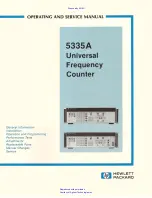
2
Collision detection
The other comparator in the 75115 is used for collision detection.
The SRN communication uses only a single transmission line, and
the transmission line is connected to each terminal. Only one pair
of terminals can communicate with each other over the transmis-
sion line at a time. If the transmission line is busy, other terminals
must wait to transmit until the line becomes available. The line
busy condition is monitored by the collision detector. The line
signal is applied to the positive input (pin 9) of the comparator,
while the local send signal is applied to the negative input (pin 11)
of the same comparator, so that correct transmission can be moni-
tored by comparing the line signal with the transmission signal. If
two terminals attempt transmission at the same time, data collision
will occur on te line, which results in the line signal being different
from the local transmission signal. Detecting this difference, the
collision detector outputs a COL signal to indicate it to the CPU.
9. Collision detect circuit
The access system employs the carrier sense multiple access with
collision detect (CSMA/CD) with a BUS type topology. The access
system has no control station on the network and checks the space
area condition of the circuit according to the prosece is available.
Collision is detected sometimes due to the delay on the circuit or the
simulataneous data sending, but the collision is detected immediately
by the collision detect circuit and prevents the deterioration of the
transmission efficiency by ptoviding the backoff process (binary
exponential backoff). The carrier sence is detected by the two stages
of the dta packet and response packet to prevent the collision of the
response packet. This permits higher efficiency for heavy loads.
Collision detect circuit is located within the MB62H149 custom LSI.
10. Carrier detect circuit
This circuit detects whether data is flowing on the transmission line. It
consists of a circuit which immediately senses a no data status on the
line.
Fig. 30
When data is not on the line the circuit functions to sense an elapse
of the fixed time rate the immediate sensing circuit is used for
response testing and the delayed sensing circuit is used for data
testing.
This circuit is located within MB62H149 custom LSI.
11. ADJUSTMENT FOR SRN
(IN-LINE) INTERFACE BOARD
If transistor Q3 in the transmitter/receiver section has been replaced
or if the SRN level requires readjustment, the following alignment is
required:
1) Tools and Instruments Required
1
Oscilloscope (50MHz or better) . . . . . . . . . . . . . . . . . . . . . . . . . . 1
2
ER-A570 . . . . . . . . . . . . . . . . . . . . . . . . . . . . . . . . . . . . . . . . . . . 1
3
ER-A57R1 . . . . . . . . . . . . . . . . . . . . . . . . . . . . . . . . . . . . . . . . . . 1
2) Dummy Network Specifications
Fig. 1 Dummy network
The oscillator should be connected to the points indicated by
⊕
and
∃
.
⊕
: Connect the positive side of the oscillator.
∃
: Connect the negative side of the oscillator.
3) Connections
Fig. 2
1
Attach the expansion PWB (CKOG–6708RCZZ) to the main PWB.
2
Attach the ER-A6IN to the expansion PWB. (Place a base under
the ER-A6IN to stabilize it.)
3
Attach the BNC connector (QCNW–6856RCZZ) to the ER-A6IN.
4) Alignment Procedure
1
When Using an Oscillator
a) Checking the 1MHz oscillator output
Using an oscilloscope check the 1MHz oscillator’s output waveform.
Fig. 3 1MHz oscillator output waveform
NOTE: The oscillator used should have an output impedance of
50
Ω
.
MB62H149
75115
65
COL
15
LINE
R1 100
Ω
J (1/4W carbon)
R2 150
Ω
J (1/4W carbon)
C1 0.01µ F (mylar firm)
C1
R1
R2
Main PWB
Expansion PWB
(CKOG-6708RCZZ)
ER-A6IN
Base
BNC connector
(QCNW-6856RCZZ)
5V
0V
0.5µ S
0.5µ S
4 14
Содержание ER-A570
Страница 62: ...13 PWB layout 1 Parts side 4 19 ...
Страница 63: ...2 Solder side 4 20 ...
Страница 73: ...7 PWB layout 4 30 ...













































